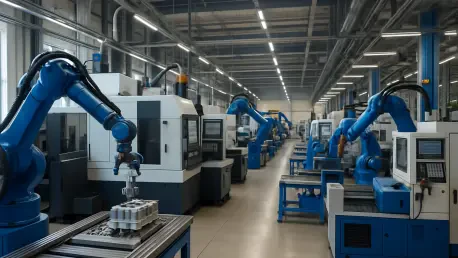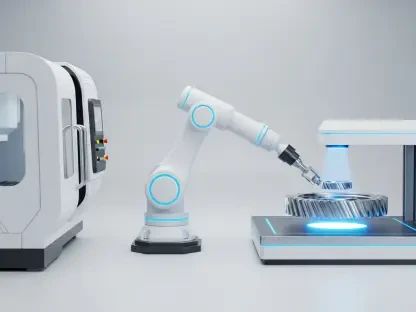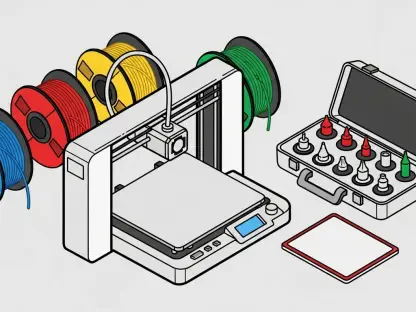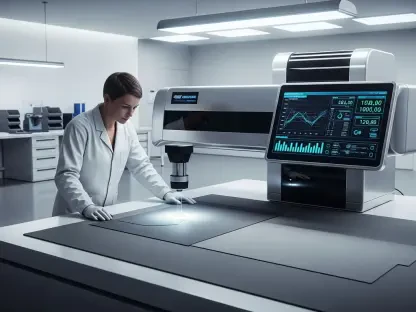In the current manufacturing landscape, companies are increasingly aligning their objectives with strategic initiatives rather than merely concentrating on the latest technological advancements. Manufacturers are realizing that true innovation comes not from possessing the most advanced technology, but from methodically integrating these advancements within their existing systems to achieve tangible business outcomes. This transformation is driven by strong leadership that prioritizes the operational needs of their businesses and channels investments wisely into data readiness and scalable architecture. By focusing on creating open interfaces and preventing vendor lock-in, smart manufacturing leaders are establishing a more flexible and robust industry foundation. These decisive actions are being seen across various sectors, where traditional manufacturing methods are being transformed through digital strategies designed to enhance operational performance, employee engagement, and cybersecurity resilience.
Strategic Decision-Making in Smart Manufacturing
In the sphere of smart manufacturing, strategic decision-making is emerging as the keystone of successful digital transformation. Manufacturers are shifting focus from merely acquiring cutting-edge technologies to making deep-rooted strategic decisions that pertain to a comprehensive understanding of operational demands and workforce engagement. This change is evident in how leading companies are prioritizing robust data architecture over immediate technological upgrades, ensuring their organizations not only acquire the latest gadgets but also prepare their ecosystems to use them effectively. By implementing platforms with open interfaces, these leaders are avoiding vendor lock-in situations, which can stifle innovation due to reliance on specific technology providers. Instead, they are fostering environments that empower companies to adapt quickly to technological changes without excessive constraints.
A case in point is the strategy employed by Georgia-Pacific, which conducted thorough operational assessments to pinpoint challenges such as employee turnover. Such profound analysis led them to integrate AI-driven solutions such as DocGen and ChatGP, focusing on knowledge retention. These tools assist in ensuring critical insights remain within the organization, offering structured documents and AI-powered interfaces to support knowledge dissemination. By focusing on strategic understanding rather than rushing toward technological adoption, Georgia-Pacific exemplifies the effectiveness of aligning technology initiatives with broader business strategies. This ensures a smoother and more holistic transition into smart manufacturing, where real innovation results from strategic foresight rather than immediate hardware possession.
The Role of Data Readiness
A critical factor in smart manufacturing’s evolution is the role of data readiness, which is increasingly becoming the linchpin in formulating effective digital strategies. Companies are realizing that the availability of clean, structured data is more crucial than possessing the latest tech in implementing Industry 4.0 priorities. As AI and machine learning become more integral to manufacturing processes, the significance of maintaining a unified data foundation becomes apparent. This involves transcending traditional siloed data systems and creating unified architectures that facilitate real-time analytics and decision-making capabilities. By prioritizing data readiness, manufacturers are able to leverage predictive tools that reduce operational inefficiencies and enhance production line effectiveness.
Rehrig Pacific serves as a prime example of prioritizing data readiness, having developed a robust data architecture for edge-to-cloud integration. This allowed for centralized, real-time data access from the production floor. Using protocol-agnostic edge layers, Rehrig Pacific enhanced their infrastructure, which facilitated predictive maintenance algorithms. Consequently, they achieved significant reductions in machine repair times, thereby increasing overall operational efficiency. Such strategic emphasis on data readiness illustrates the transformational impact of focusing on foundational infrastructure to support cutting-edge technological applications. It underscores the importance of data as the cornerstone for effective digital transformation in smart manufacturing, empowering companies to harness advanced technologies more meaningfully.
Unified Data Architecture and Interface
The creation of a unified data architecture and open interfaces constitutes a central pillar in the successful digital transformation of manufacturing companies. By establishing a cohesive data framework, companies can ensure seamless communication among disparate systems and enhance decision-making capabilities. This unified approach is critical in overcoming legacy system divides and integrating advanced technologies effectively into the manufacturing process. Open interfaces foster the agility needed to adapt to technological changes, preventing vendor lock-in and promoting competitive innovation.
Gousto’s implementation of FactoryOS exemplifies the strategic focus on a unified data foundation. Using this centralized platform, Gousto organized data with a Unified Namespace that connected various factory systems, thus enhancing visibility and decision-making processes. This approach significantly improved the mechanical availability of systems and reduced downtime-related financial losses. FactoryOS enabled Gousto to create a scalable, adaptable framework that effectively supports new tech integrations without compromising operational stability or future adaptability. By emphasizing a unified data architecture, companies like Gousto illustrate a strategic foresight that allows for meaningful incorporation of advanced technologies, optimizing both efficiency and flexibility within smart manufacturing systems.
Employee Engagement and Cybersecurity
Successful transformation within smart manufacturing heavily depends on effective change management and workforce engagement. Employees must be actively aligned with the technological systems to drive sustained digital transformation efforts. This encompasses creating an environment conducive to adaptive learning and fostering a culture that embraces tech-driven change. Additionally, as technology becomes more intricate, robust cybersecurity measures and governance by design must be integrated to protect sensitive data while enabling seamless operational processes.
Employee engagement emerges as a critical success factor, necessitating change management practices that incorporate active participation from the workforce. Through comprehensive training programs and supportive management systems, manufacturers can ensure employees are fully committed to the new technological directions. Meanwhile, cybersecurity must be woven into the fabric of digital transformation strategies. This involves not only safeguarding data integrity and privacy but embedding a comprehensive governance architecture that anticipates and mitigates potential cybersecurity threats. By engendering both strong employee buy-in and integrating cybersecurity intrinsically, manufacturers are building resilient ecosystems that effectively support smart technology adoption.
Conclusion and Future Considerations
In the realm of smart manufacturing, strategic decision-making is becoming the crucial element for a successful digital transformation. Manufacturers are shifting away from merely acquiring the latest technologies and are now making foundational strategic decisions. These decisions revolve around a deep comprehension of operational needs and engaging their workforce effectively. This shift is evident as leading firms focus on building robust data architectures before jumping into quick technological upgrades. They prioritize not just getting the newest gadgets but also readying their systems to utilize them efficiently.
By embracing platforms with open interfaces, these companies avoid vendor lock-in scenarios that might restrict innovation through dependence on specific technology providers. Instead, they cultivate environments that allow companies to adapt swiftly to technological changes with minimal restrictions.
Take Georgia-Pacific as an example—they conducted extensive operational evaluations to identify issues like employee turnover. This level of analysis led to the integration of AI-driven tools like DocGen and ChatGP, aimed at retaining knowledge. These tools help keep crucial insights within the organization by offering structured documents and AI-powered interfaces for distributing knowledge. Georgia-Pacific’s approach demonstrates how aligning technology initiatives with comprehensive business strategies leads to a smooth transition into smart manufacturing. True innovation stems from strategic foresight, not just owning the latest hardware.









